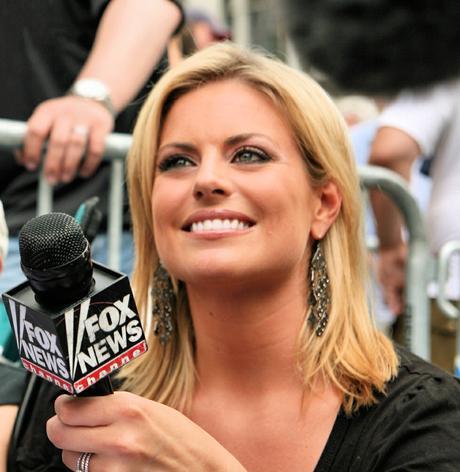
Why is beauty a requirement for broadcast journalism?
If you google “Fox News female anchors,” the first few results that pop up include, “Top Ten Hottest Fox News Girls,” “Sexy Fox News Anchor Suffers HUMILIATING Wardrobe Malfunction,” “19 Sexiest Women of Fox News,” and “CNN Women versus Fox Women.” Search a little deeper and you’ll find PunditFact’s sorting of these women by hair color and Howard Stern’s NBA-playoffs-style seeding of their hotness organized into a bracket. The prevalent hyper-glamorization of these female journalists sends a clear message to their viewers: There is a beauty qualification for women in this profession that just doesn’t exist for their male counterparts.
This double standard is undoubtedly hyper-evident in this industry but hardly limited to it. In her 1990 book The Beauty Myth, journalist and author Naomi Wolf coined the term “Professional Beauty Qualification,” or PBQ — a twist on the U.S. sex discrimination law term BFOQ (Bona Fide Occupational Qualification.) While PBQ is a precarious but generally accepted condition for women’s hiring and promotion across professions, it is particularly evident in broadcast journalism, Wolf notes in the book. The author alludes to the common image of a middle aged male anchor accompanied by a sexy, much younger female newscaster. While he usually wears a nondescript suit, she will most likely be clad in a dress that emphasizes her thin physique and toned limbs.
The enforcement of this gendered double-standard of on-cam glam is likely not just driven by pure sexism, but also a need for higher ratings, which in turn seems to have forced the news sector to increasingly mimic the entertainment sector. Female “sexiness” has long been a professional standard in the entertainment industry and now sexiness seems to be a legitimate expectation of female newscasters.
“It’s a visual business,” Megyn Kelly commented in an GQ article which was notably originally titled “She Reports, We Decided She’s Hot,” and which was accompanied by a photo shoot in which she bared (nearly) all. “People want to see the anchor,” Kelly added — a sentiment Katie Couric echoed when she once described the get-ups female anchors as appropriate for “going clubbing.”
Kelly is hardly the only female anchor to pose in a decidedly sexualized way for a major publication, either. Mika Brzezinski of “Morning Joe” did a Vanity Fair photo shoot in which she was suggestively positioned on a table, her Louboutin-clad leg in the air, while her co-host Joe Scarborough sits professionally nearby. In a promotional photo for her Fox News show, Elisabeth Hasselbeck is a shining beacon of pink sandwiched between avuncularly positioned between her co-hosts Steve Doocy and Brian Kilmeade — the latter of whom once even joked that the process of choosing female hosts requires going “into the Victoria’s Secret catalogue, and we say ‘Can any of these people talk?'” in one 2012 radio segment.
Kilmeade’s statement is hardly just reflective of his own personal, offensive views, but indicative of a broader issue, according to Hannah Groch-Begley of Media Matters for America. “[Women] are there for their physical appearance,” she told Broadly. “And maybe they’ll say something interesting, maybe they won’t.”
“When you go on Fox you’re automatically not legitimate,” Dr. Caroline Heldman, an Associate Professor of Politics at Occidental College, added. “You’re there as eye candy and to be scoffed at. That is your role on Fox if you’re a woman.”
While it might seem that female journalists who meet these beauty standards have power in the industry, this power is actually precarious. Walking the tightrope between being “sexy” and “getting by on one’s looks” is a challenge itself.
“You can’t win either way,” ESPN’s Sarah Spain once said about the struggle to strike a balance between looks and qualifications. “Either you’re too beautiful and you don’t know what you’re talking about, or you’re too ugly and I don’t want to watch you.”
Finding a middle ground is actually altogether impossible, according to Wolf. Women can be talented and “unbeautiful” — and therefore invisible and their merit rendered irrelevant — or beautiful and achieve visibility, but without receiving credit for their merit, she posited. What’s more, success is still limited even for those who are beautiful because upon aging, “they disappear,” Wolf added. One need look no further for evidence of this than the horrifying case of Christine Craft, a journalist who was fired for being “too old, too ugly, and not deferential enough to men.” As Wolf concluded, being rewarded for beauty is essentially to “receive a prize with an expiration date.”
While this dynamic is unacceptable, it’s also important to note that women who consider their appearance empowering in some way shouldn’t be inherently shamed, either. The key here is power — namely who holds it. Women should have control over whether they find their appearance empowering or not rather than feel that beauty is a requirement imposed on them or a barrier to power they must overcome.
In this way, the beauty double standard evident in the realm of broadcast journalism serves as a case study of a the broader, implicit message evident in our society that women’s success is dependent on the intersection of sexuality and self-esteem that we call “beauty.” Even in the common, routine act of watching the news, young women are reminded that professional success requires a “third shift” — the time-consuming and unpaid work of maintaining their image.
Ultimately, Wolf puts it best. “To find out what’s going on in the world,” she wrote, “involves the reminder to women that this is going on in the world.”

